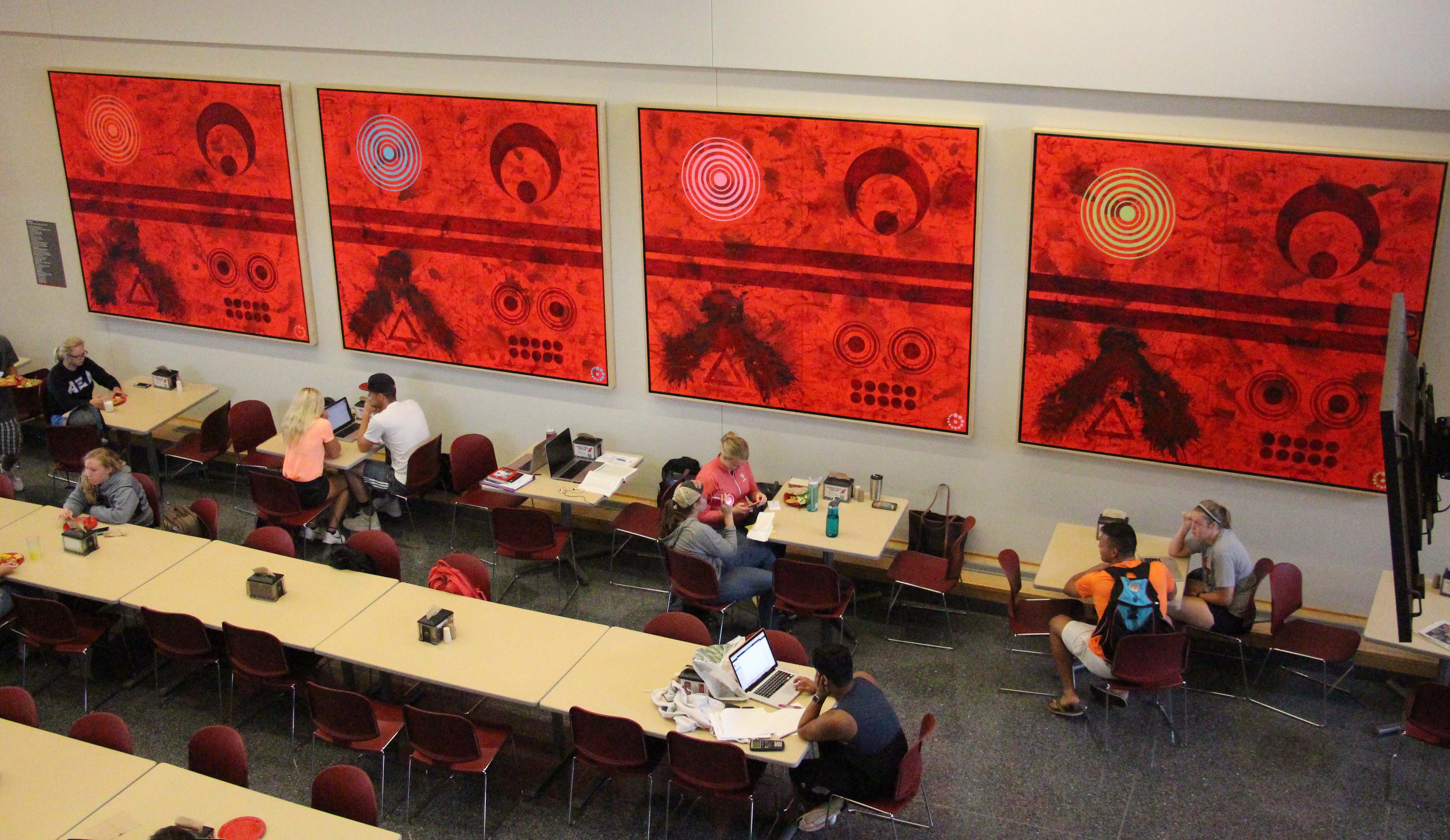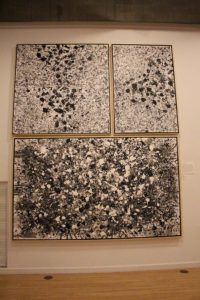
USD alum featured in gallery, donates paintings worth $550,000
USD alum J. Steven Manolis is hoping to paint the town red.
Manolis was born in Vermillion and graduated with honors in business from USD in 1970. He currently lives in Miami, FL and works as a full-time painter.
Manolis recently donated seven paintings to USD, which are valued at $550,000. These works will be permanently displayed in the Muenster University Center, the Beacom School of Business and the Warren M. Lee Center for the Fine Arts as part of his “Redworld” series.
More of his works are also on display in the John A. Day gallery until Oct. 9 as part of his “Painting Vermillion Red” exhibition. As part of the exhibition, there will be an art critics symposium on Oct. 5 and a closing reception on Oct. 6 where Manolis will walk through the exhibition and talk about each of his works.
Manolis will also be the grand marshal at the Dakota Days parade.
“I’m very honored to be a USD graduate,” Manolis said. “I really hope that as many people as possible can have the opportunity to go see the show and read all about each one of the works while they’re in the show.”
The “Redworld” paintings were inspired by a poem of the same name that Manolis wrote about non-discrimination. The poem is posted next to the paintings in the MUC and in Beacom.
He said college is one of the first times people encounter issues of discrimination.
“Inspiration behind the poem relates to the philosophy of social focus, non-discrimination on any basis whether that be culturally, racially, religiously, ethnically, sexually or by gender,” Manolis said. “I believe in those values very strongly. The first time and maybe the most important time that a student had the opportunity to take control of their own life is in college. My poem was an attempt to inspire college-age kids, and I have labeled it and quoted it as art, as positive activism.”
Tena Haraldson, director of marketing, communications & university relations, said she was impressed by Manolis when she met him.
“I’m really impressed by his energy and his ability to take a project and foresee himself doing it,” Haraldson said.
She said the theme of Manolis’ “Redworld” poem relates to the university’s policy of inclusive excellence.
“We have inclusive excellence where we try to involve all kinds of people on our campus. He really feels that way as a person, so he wanted to write that poem and give USD those paintings as a way to raise those discussions and remind students to think about that equality and to be respectful of everyone,” she said. “He has a really strong conviction about sexual equality and everyone being treated with respect.”
Larry Schou, dean of fine arts, met Manolis three years ago when the USD Foundation asked if he would contact Manolis as a potential donor. They’ve been chatting since then, and Schou said he asked him to display some of his paintings in an exhibition.
“He had mentioned that South Dakota, Vermillion and the university is very important to him,” Schou said. “He wanted to give back but wasn’t sure what that might mean. As we chatted over the years, he said he’d like to donate some artwork of his that he created specifically for us. Then as we continued to talk, I said it’d be great to have an exhibition with a variety of pieces, not just ‘Redworld,’ but all the other types of pieces he creates.”
Communicating through art
Schou said “Painting Vermillion Red” is the largest exhibition the John A. Day gallery has ever had. Manolis stacks the paintings vertically in the space, creating more visual interest.

One particular work, “Black & White,” is supposed to represent Manolis’ lifetime in different spans through three paintings displayed vertically.
“(Manolis) said these black blotches represent his walk of life,” Schou said of the works. “The bottom one is birth to 60, above is 60 to 68, he’s 68-years-old, and the side panels are his future. I haven’t seen anyone going vertical like this and really using all the space to the top, which I think is exciting. Not all art museums are like this.”
Schou said a lot of Manolis’ works are abstract, but they still carry weight and meaning.
“It becomes personalized for him, but you have to know his past to know some of the images,” he said. “When you know more about an artist, you know the inside secrets about their life and the stories of their life, and all of a sudden you see it in lots of places and it starts to pop and makes it even more exciting.”
Manolis said a triangle in one of his “Redworld” pieces symbolizes Delta, the fraternity Manolis joined on campus, and that dots count for his children and grandchildren. Manolis also uses concentric circles to tie into the theme of social focus and non-discrimination, he said.
Manolis studied under Wolf Kahn, a leader in the abstract expressionist movement. Manolis said he likes to paint large-scale to make his paintings more powerful.
“When you paint in a scale like this, it becomes more conducive to imparting emotion and spirituality and that’s what I attempt to do with color. I think it becomes more powerful as the scale goes up,” he said.
Manolis said he sees abstract art as the most effective way of communicating.
“A lot of people really do not understand abstract expressionism. First-generation abstract expression is some of the most valuable art in the world,” he said. “Abstract refers to whether or not work is representational or not.”
Manolis said although abstract art is often misunderstood, personal descriptions always accompany his works.
“When I paint, I paint with a meaning,” he said. “I’m a colorist, I paint with meaning and communication in each of my works.”


